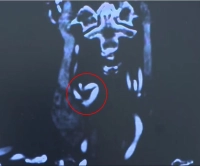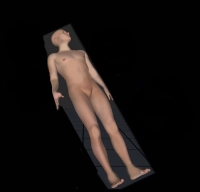Medical history
- Vascular risk factors: Smoking, arterial hypertension, lipid metabolism disorders, diabetes
Clinical neurological examination
- > 90% of all stenoses and occlusions of supraaortic vessels (ICA, vertebral artery, etc.) remain clinically asymptomatic and are discovered as incidental findings in screening examinations or preoperative imaging
- The symptoms of a lesion in the vessels supplying the brain depend on the affected vessel, the course over time and the predominant collateralization (e.g. via the circle of Willis)
- Typical symptoms of a carotid artery (internal carotid artery) lesion include:
◊ motor or sensory hemi-symptoms (e.g. "hemiplegia/hemiparesis")
◊ Amaurosis fugax (temporary unilateral blindness: ophthalmic artery)
◊ cortical dysfunction (speech, visual-spatial perception)
◊ homonymous bilateral visual field restrictions are usually not characteristic symptoms of internal carotid artery stenosis
- Important: Carotid artery auscultation is not suited for detecting stenoses.
Cardiological examination
- 30% of patients present with CHD warranting treatment
Color-coded duplex sonography
Ultrasonography of the extracranial vessels supplying the brain should always examine all vessels in the transverse and longitudinal plane:
- Common carotid artery from proximally to carotid bifurcation
- Carotid bifurcation with dorsolateral internal carotid artery
- External carotid artery
- Vertebral artery in segments V1 to V3
- Subclavian and axillary arteries
Search for hemodynamically significant plaques and their morphological description (B-scan):
- Hyperechoic versus hypoechoic
- Homogeneous versus inhomogeneous
- Smoothly delineated versus irregular configuration
Plaque parameters with unfavorable prognosis:
- Hypoechoic internal plaque structure
- long plaque >1 cm
- Plaque diameter >4 mm
- Longitudinal pulsation of plaque distad
According to international agreement, stenoses should be quantified according to the NASCET criteria.
Contrast-enhanced MR angiography or alternatively a CT angiography
- Validation of the findings or for treatment planning
- Assessment of intracranial vessels and possible parenchymal damage (previous cerebral infarctions)
Digital subtraction angiography (DSA) of the arteries supplying the brain
- only if definite diagnosis is not possible with the noninvasive modalities and therapeutic consequences result
- Example: kinking with luminal narrowing not visible on MRT or CT
CT or MRI of the brain
- in symptomatic patients parenchymal imaging before planned revascularization
- in asymptomatic patients, such imaging can provide valuable additional information, e.g., evidence of clinically silent cerebral infarction
Chest radiograph
Clinical chemistry
- RBC
- Electrolytes
- Coagulation
- Renal function
- Liver function
- Blood lipids
- Blood group
In all patients with atherosclerotic carotid stenosis, look for any secondary sequelae of arteriosclerosis (coronary heart disease [CHD], peripheral arterial occlusive disease [PAOD])!



